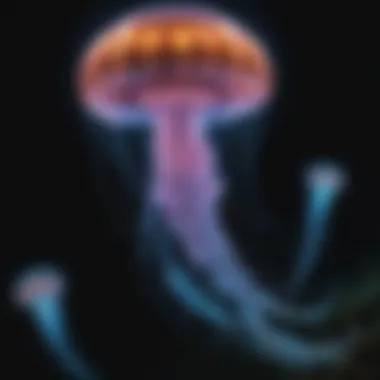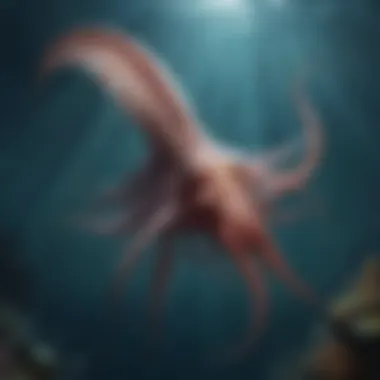Delving into the Enigmatic Lives: Deep-Sea Animals at the Ocean's Bottom


Science Fun Facts
As we begin our descent into the hidden world of the ocean floor, a realm shrouded in mystery and beauty, we uncover a tapestry of life that thrives in the depths of the sea. Little-known to many, the creatures that inhabit this twilight zone are wonders of nature, adapted to survive in extreme conditions where sunlight struggles to penetrate, giving rise to intricate ecosystems that are waiting to be discovered. From the ethereal dance of bioluminescent beings to the stealthy movements of elusive deep-sea dwellers, each organism plays a vital role in the delicate balance of the underwater world. Prepare to embark on a journey that will unveil the mesmerizing secrets of the animals at the bottom of the ocean, a journey filled with awe-inspiring encounters and profound revelations.
Introduction to Deep-Sea Life
When delving into the hidden world of animals at the bottom of the ocean, one cannot overlook the paramount importance of understanding the life forms existing in the abyssal depths. Providing a gateway to a realm less explored, this section serves as a crucial foundation for unraveling the mysteries of the deep sea. By highlighting the unique characteristics and adaptations of creatures thriving in this extreme environment, we gain invaluable insights into the resilience and diversity of oceanic ecosystems. Exploring the abyssal zone unveils a plethora of species with exceptional survival strategies, shedding light on the interconnectedness of marine life and the delicate balance of underwater habitats.
The Abyssal Zone
Characteristics of the Abyssal Zone
Diving deeper into the abyssal zone reveals a world characterized by immense pressure, eternal darkness, and chilling temperatures. The extreme conditions of this zone foster a distinct ecosystem where only the most specialized organisms can thrive. From the complete absence of sunlight to the nutrient-rich sediments lining the ocean floor, each characteristic of the abyssal zone plays a pivotal role in shaping the fauna and flora that call this region home. Understanding these unique features is essential for deciphering the complexities of deep-sea life and appreciating the marvels of evolution at its most extreme.
Extreme Conditions and Adaptations
Venturing into the abyssal zone confronts creatures with extraordinary challenges, necessitating remarkable adaptations for survival. From bioluminescence to pressure-resistant anatomies, denizens of the deep sea have evolved ingenious strategies to thrive in this hostile environment. Exploring the adaptations required to withstand the crushing pressures and frigid temperatures highlights the resilience and resourcefulness of deep-sea animals. These extreme conditions not only test the limits of biological possibility but also showcase nature's boundless creativity in the face of adversity.
Importance of Studying Deep-Sea Animals
In the pursuit of scientific knowledge, studying deep-sea animals unveils a treasure trove of discoveries waiting to revolutionize our understanding of oceanic life. Delving into the depths allows researchers to uncover unique species unlike any found on the surface, offering a glimpse into the diversity of marine ecosystems. By studying deep-sea animals, scientists can not only unravel the mysteries of evolution but also witness firsthand the intricate dynamics that govern life in the oceans.
Discovering Unique Species


The exploration of deep-sea habitats often leads to the discovery of species that challenge conventional biological norms. From bioluminescent fish to transparent invertebrates, each unique find adds a new dimension to our comprehension of biodiversity. By delving into the depths, researchers can identify new species with astonishing adaptations and behaviors previously unseen. Embracing the discovery of these unique creatures paves the way for advancements in taxonomy, ecology, and conservation, underscoring the significance of studying deep-sea animals.
Impact on Marine Ecosystems
Beyond their novelty, deep-sea animals play a vital role in maintaining the delicate balance of marine ecosystems. Understanding the impact of these organisms on their environment is essential for safeguarding the health of our oceans. By studying the interactions between deep-sea species and their surroundings, scientists can pinpoint crucial ecological relationships that influence nutrient cycling, population dynamics, and habitat stability. Recognizing the significance of deep-sea animals in shaping marine ecosystems underscores the urgency of conservation efforts aimed at preserving these valuable and enigmatic creatures.
Bioluminescent Wonders
Bioluminescent wonders occupy a significant segment dedicated to unraveling the mysteries of the deep-sea world. The luminescent beauty exhibited by these organisms serves as a captivating element of the marine ecosystem at the ocean floor. This section meticulously dissects the intricate mechanisms and functions of bioluminescence, shedding light on a fascinating aspect of underwater life.
Bioluminescence in Deep-Sea Creatures
Mechanism of Bioluminescence
Bioluminescence plays a crucial role in deep-sea creatures, acting as a beacon in the darkness of the ocean depths. The specific process at the core of bioluminescence involves a biochemical reaction between luciferin and oxygen, catalyzed by the enzyme luciferase, resulting in the emission of light. This mesmerizing phenomenon aids marine organisms in attracting prey, deterring predators, and communicating with their counterparts in the lightless abyss. The efficiency and effectiveness of bioluminescence highlight its adaptive advantage in the perpetually dark environment of the deep sea.
Examples of Bioluminescent Species
The deep seas harbor a diverse array of bioluminescent species, each showcasing unique adaptations and characteristics. Creatures like flashlight fish, anglerfish, and ostracods are notable examples renowned for their bioluminescent abilities. These species leverage bioluminescence for a myriad of purposes, such as luring prey, camouflaging themselves in the bioluminescent background, and attracting mates. The evolution of bioluminescence in various deep-sea organisms reflects a remarkable strategy for survival, underscoring the biological significance of this phenomenon.
Role of Bioluminescence in Survival
Camouflage and Communication


Bioluminescence serves as a dual-purpose tool for deep-sea inhabitants, aiding in both camouflage and communication. Organisms like the firefly squid utilize bioluminescence to create disruptive patterns, effectively blending into their luminous surroundings and evading detection from predators. Additionally, some species employ bioluminescent displays to communicate with conspecifics, signaling mating rituals, territory boundaries, or alarm signals. The multifaceted nature of bioluminescence underscores its adaptive value in enhancing survival strategies among deep-sea creatures.
Predator Avoidance
Predator avoidance stands as a critical aspect in the survival repertoire of deep-sea organisms, with bioluminescence offering a solution to evade threats from predators. Certain species utilize flashes of light to startle or confuse predators, allowing for swift escape or diversion tactics. By harnessing the power of bioluminescence, these organisms demonstrate a sophisticated defense mechanism against potential dangers lurking in the deep-sea environment. The intricate dance between bioluminescence and predator avoidance unfolds as a compelling adaptation strategy in the biological tapestry of deep-sea life.
Enigmatic Deep-Sea Species
Delve into the intriguing realm of deep-sea species, an essential component of this exploration into the hidden world residing at the ocean's depths. These enigmatic creatures offer a unique perspective on the biodiversity of the marine ecosystem, unveiling extraordinary adaptations and behaviors that fascinate researchers and enthusiasts alike. By shedding light on these mysterious inhabitants, we gain a deeper understanding of the complexities of life in the profound seas.
Giant Tube Worms and Hydrothermal Vents
Unique Adaptations to Extreme Environments
Embark on a journey to discover the unparalleled adaptations of giant tube worms thriving near hydrothermal vents. These intriguing creatures have evolved distinct mechanisms to survive in the harsh conditions of the deep-sea, showcasing specialized features that set them apart from other marine species. Their ability to withstand extreme pressures and utilize chemosynthesis as a primary energy source highlights the resilience and adaptive nature of these fascinating organisms. Exploring their unique adaptations provides invaluable insights into the wonders of deep-sea ecosystems.
Chemosynthesis and Ecosystem Dynamics
Explore the intricate relationship between chemosynthesis and the dynamics of deep-sea ecosystems. Delving into the process by which organisms like giant tube worms harness energy from inorganic compounds, we unravel a crucial ecological mechanism that sustains life in these challenging environments. The impact of chemosynthesis on nutrient cycling and species interactions underscores its significance in shaping the delicate balance of deep-sea ecosystems. By examining the role of chemosynthesis in ecosystem dynamics, we uncover the profound interconnectedness of life beneath the ocean's surface.
Dumbo Octopus and Other Rare Finds
Unusual Morphology and Behaviors


Uncover the remarkable morphology and behaviors of the elusive dumbo octopus and other rare deep-sea discoveries. These captivating creatures boast unconventional adaptations, from unique body structures to intriguing locomotor patterns, enhancing their survival in the depths of the ocean. By delving into their distinctive traits and behaviors, we gain insight into the diverse strategies employed by deep-sea species to thrive in varying environments. Exploring the unusual morphology and behaviors of these rare finds adds a layer of intrigue to our understanding of the evolutionary adaptations that shape marine life.
Discovery Challenges and Research Efforts
Navigate through the challenges and triumphs of discovering and studying deep-sea creatures like the dumbo octopus. Overcoming obstacles such as limited accessibility and technological constraints, researchers dedicate relentless efforts to unravel the mysteries of these elusive beings. By highlighting the intricacies of scientific exploration in remote oceanic regions, we recognize the importance of perseverance and innovation in advancing our knowledge of deep-sea ecosystems. The ongoing research efforts shed light on the complexities of studying rare deep-sea species, inspiring fascination and admiration for the depths of the ocean.
Conservation Concerns and Future Prospects
In this section of the article, we delve deep into the critical aspect of Conservation Concerns and Future Prospects related to the hidden world of animals at the bottom of the ocean. This topic holds paramount importance as it sheds light on the pressing need to protect and sustain the fragile marine ecosystems that exist in the depths of the sea. By addressing conservation concerns and exploring future prospects, we aim to raise awareness about the challenges faced by these unique creatures and the environmental impacts that affect their habitat. Through careful analysis and proactive measures, we can help ensure the longevity and vitality of these deep-sea ecosystems for generations to come.
Threats to Deep-Sea Habitats
Deep-Sea Mining Impact
Exploring the specific dimension of Deep-Sea Mining Impact is crucial in understanding the overarching threats faced by deep-sea habitats. The practice of deep-sea mining involves extracting valuable minerals from the seafloor, leading to significant disturbances in the delicate balance of these underwater ecosystems. One key characteristic of Deep-Sea Mining Impact is its potential to disrupt seabed communities and alter geological formations, posing a considerable risk to unique species that rely on these habitats for survival. Despite claims of economic benefits, the environmental consequences of deep-sea mining outweigh its advantages, making it a contentious issue that demands further examination within the context of this article.
Pollution and Climate Change
Another critical aspect contributing to the degradation of deep-sea habitats is Pollution and Climate Change. The accumulation of pollutants in the marine environment, coupled with the effects of climate change, poses a severe threat to the stability and biodiversity of deep-sea ecosystems. Pollution from human activities, such as plastic waste and chemical runoff, can have detrimental effects on marine species and their habitats. Additionally, the rising sea temperatures and ocean acidification caused by climate change further exacerbate the challenges faced by deep-sea organisms. Understanding the unique features of Pollution and Climate Change is vital in mitigating their impacts and fostering sustainable practices that promote the conservation of these precious ecosystems highlighted in this article.
Exploration and Sustainable Practices
Balancing Research and Conservation
Delving into the intricacies of Balancing Research and Conservation unveils the delicate equilibrium required to promote the preservation of deep-sea habitats. This aspect emphasizes the need to conduct comprehensive research to better comprehend these ecosystems while simultaneously implementing conservation measures to safeguard their integrity. The key characteristic of Balancing Research and Conservation lies in fostering a synergy between scientific inquiry and environmental protection, ensuring that advancements in deep-sea exploration contribute to the sustainable coexistence of humans and marine life. By striking a balance between research initiatives and conservation efforts, we can pave the way for responsible stewardship of the profound marine environments elucidated in this article.
International Collaboration for Protection
Lastly, the significance of International Collaboration for Protection cannot be overstated when addressing the conservation needs of deep-sea habitats. This aspect underscores the importance of global cooperation and shared responsibility in safeguarding the world's oceans and marine biodiversity. International collaboration offers a holistic approach to conservation by integrating diverse perspectives, expertise, and resources to effectively protect deep-sea ecosystems. The unique feature of International Collaboration for Protection lies in its capacity to foster partnerships across borders, facilitating collective action towards the preservation and sustainable management of the marine resources discussed throughout this article.





